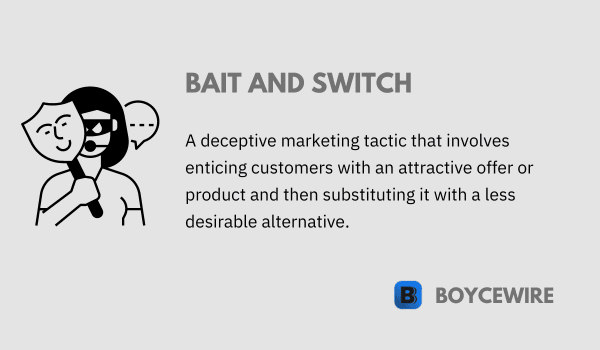Bait and Switch: Definition, Types & Examples

What is Bait and Switch?
The world of marketing and advertising is filled with various strategies, all designed to draw the attention of potential customers and convince them to make a purchase. Among these strategies is one known as “bait and switch.” This term, with origins dating back to the early 20th century, refers to a type of deceptive practice that lures customers in with the promise of a great deal on a product or service, only to then switch the promised product or service with one that is more expensive or of lower quality.
This practice, while seen as unethical and often illegal, unfortunately continues to be used by some businesses, largely due to its initial effectiveness at attracting customers. However, the repercussions that come with bait and switch, including legal consequences and damage to a business’s reputation, typically outweigh any short-term gain.
Key Points
- Bait and switch is a deceptive sales tactic used by businesses to attract customers with an enticing offer or product and then substitute it with something less desirable.
- The purpose of bait and switch is to lure customers in and upsell or sell them a different product or service.
- It often involves advertising a popular or highly discounted item to create excitement and draw customers to the business.
Understanding Bait and Switch
“Bait and Switch” is a controversial marketing tactic where customers are “baited” by advertising a product or service at an incredibly attractive price, only to find that it’s no longer available when they visit the store. The customer is then “switched” to a more expensive or less attractive alternative.
There are two main components of bait and switch:
- The Bait This is the initial product or service that is advertised, usually at an unbelievably low price, and is designed to attract potential customers. This bait could be promoted through various channels, such as television or radio ads, online marketing, and print advertisements. The goal of the bait is to spark the interest of consumers and lure them into the store or online platform.
- The Switch When the customer shows interest in the bait, they are informed that the advertised product is unavailable for reasons like it has been sold out, or it’s of inferior quality, etc. The seller then attempts to switch the consumer to a more expensive product or a product of similar value but higher profit margin.
It’s important to note that bait and switch is considered an unethical and often illegal business practice because it is fundamentally deceptive. It betrays customer trust, damages a business’s reputation, and can result in serious legal consequences. Yet, despite these downsides, some businesses still resort to this tactic, primarily because of its effectiveness in attracting potential customers.
Types of Bait and Switch
There are several ways in which a bait and switch strategy can be employed. Here are a few of the most common types:
- Classic This is the most straightforward type of bait and switch. A business advertises a product at an incredibly low price to lure in customers, then claims that the product is out of stock or discontinued and directs them to a more expensive or profitable alternative.
- Upselling In this case, the advertised product is available, but salespeople disparage it, citing poor quality, lack of features, or other negatives, to persuade customers to buy a pricier alternative.
- Bundling The advertised product is available, but customers are told they must purchase additional products or services to go along with it, increasing the overall cost.
- Location This occurs when a business advertises a deal that is only available at a different location or branch, leading to inconvenience for the customer and potentially pushing them to purchase an alternative product from the more accessible location.
Each of these types shares the common goal of luring customers in with an enticing offer, only to switch it with an alternative that is more beneficial to the seller.
Legal Implications of Bait and Switch
While bait and switch can be a powerful tool for businesses to attract customers and boost sales, it is widely considered deceptive and unethical. Many jurisdictions have laws in place to protect consumers from such practices.
In the United States, for example, the Federal Trade Commission (FTC) has clear regulations that make bait and switch advertising illegal. These regulations state that businesses must have the advertised product in stock and available for purchase at the advertised price during the duration of the promotion. If the business attempts to sell a different product or adds undisclosed costs, they can face legal repercussions.
Similarly, in the European Union, the Unfair Commercial Practices Directive prohibits any misleading and aggressive commercial practices, which includes bait and switch advertising. Businesses found guilty of using such tactics can face hefty fines and reputational damage.
Despite these regulations, enforcement can be challenging. It often falls upon the consumer to identify and report instances of bait and switch, and proving that a business intentionally engaged in this practice can be difficult. Therefore, while the legal landscape provides some deterrent, it’s also essential for consumers to remain vigilant and informed.
Bait and Switch vs Ethical Advertising
Ethical advertising and bait and switch are two opposite ends of the spectrum when it comes to marketing practices.
Bait and switch is a deceptive strategy that involves advertising a product or service at a low price or with attractive terms to lure customers. Once customers show interest, the advertiser reveals that the advertised product or service is not available or the terms are not as favorable as advertised. Instead, a more expensive or less favorable item is offered. This practice is generally considered unethical and is illegal in many jurisdictions because it relies on deception to attract customers.
On the other hand, ethical advertising is all about transparency, honesty, and respect for the consumer’s right to information. In ethical advertising, all claims made in the advertisement are accurate, all terms are clearly disclosed, and there is no intent to mislead the consumer. Ethical advertisers respect the intelligence and autonomy of their consumers, understanding that long-term customer relationships are built on trust.
While bait and switch may generate immediate sales, it can damage a company’s reputation and customer relationships in the long run. Ethical advertising, while perhaps not creating the same level of immediate excitement or urgency, builds a solid foundation of trust and credibility with consumers, which can lead to long-term customer loyalty and sustained business growth.
Avoiding Bait and Switch
Bait and switch tactics can often be deceptive and difficult to spot, especially when the advertiser is subtle. However, there are several strategies you can use to recognize and avoid falling for these tactics:
- Too Good to be True If a deal seems too good to be true, it probably is. Be wary of products or services that are advertised at a significantly lower price than what is offered by other companies.
- Limited Details Ads that lack detailed information about the product or service, or the terms of the deal, might be a sign of bait and switch. Reputable companies typically provide all relevant information in their ads.
- Availability Be cautious if the advertised product is often out of stock or isn’t available in your area, but a more expensive or less desirable alternative is readily available.
- Pressure Sales Tactics Unfair sales practices sometimes employ aggressive tactics to persuade customers into purchasing higher-priced products. If you experience a sense of urgency or pressure, it may indicate the use of deceptive sales techniques.
- Read Reviews Checking online reviews or Better Business Bureau ratings can provide insight into whether a company regularly practices bait and switch tactics.
To avoid falling for bait and switch tactics, it’s important to be an informed consumer. Do your research, compare prices, read the fine print, and don’t be afraid to walk away if something doesn’t feel right. Remember, a legitimate company won’t resort to deceptive practices to lure customers.
Examples of Bait and Switch
Bait and switch tactics can occur in a variety of industries, from retail to services. Here are a few examples:
- Electronics Stores A common example of bait and switch happens in electronics stores. A retailer might advertise a high-end television at an incredibly low price to lure customers into the store. However, once customers arrive, they are told the advertised TV is out of stock, but a more expensive model is available instead.
- Car Dealerships Car dealerships often use bait and switch tactics. They might advertise a car at a certain price or with specific features, but when customers show up to buy, they are told the car is no longer available, and they are directed towards a more expensive model.
- Travel and Tourism Industry Travel companies may advertise a vacation package at a low price, but when customers attempt to book the vacation, they discover hidden fees or are told the package is sold out and are offered a more expensive trip instead.
- Internet Service Providers Some internet service providers advertise a certain speed or price, but once customers sign up, they realize the promised speed is only available in certain areas or the price increases after a trial period.
- Supermarkets A grocery store may advertise a popular item at a low price, but when customers arrive, they discover the store is out of stock. The store might suggest a more expensive product or a different brand at a higher price as an alternative.
In all these examples, the common thread is the tactic of attracting customers with a seemingly advantageous offer, only to coax them into accepting a different, usually more expensive, offer.
FAQs
Bait and switch is a deceptive sales tactic where businesses advertise an attractive product or offer to lure customers, but then substitute it with a less desirable alternative.
Businesses attract customers by advertising a desirable product or offer at an attractive price. However, when customers show interest or arrive at the store, they are informed that the advertised item is no longer available or not as good as advertised. Instead, they are encouraged to purchase a different, often more expensive, product.
Bait and switch is used to attract customers and increase sales by capturing their attention with an enticing offer. Once customers are interested, businesses attempt to upsell or convince them to buy a different product.
Bait and switch is generally considered illegal in many countries as it is a deceptive practice that misleads consumers. Laws and regulations exist to protect consumers from such practices, and businesses engaging in bait and switch can face legal consequences.
About Paul
Paul Boyce is an economics editor with over 10 years experience in the industry. Currently working as a consultant within the financial services sector, Paul is the CEO and chief editor of BoyceWire. He has written publications for FEE, the Mises Institute, and many others.

Further Reading
 Agribusiness - Agribusiness refers to the integrated and commercialized agricultural activities that encompass production, processing, distribution, and marketing of agricultural products.
Agribusiness - Agribusiness refers to the integrated and commercialized agricultural activities that encompass production, processing, distribution, and marketing of agricultural products.  Inelastic Demand: Definition & Examples - Inelastic demand is where the demand for a good does not significantly respond to changes in price.
Inelastic Demand: Definition & Examples - Inelastic demand is where the demand for a good does not significantly respond to changes in price.  Economic Efficiency - Economic efficiency refers to the optimal allocation of resources to maximize overall welfare or output.
Economic Efficiency - Economic efficiency refers to the optimal allocation of resources to maximize overall welfare or output. 
